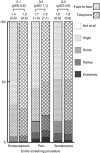Face-to-face vs telephone pre-colonoscopy consultation in colorectal cancer screening; a randomised trial
- PMID: 22918392
- PMCID: PMC3461154
- DOI: 10.1038/bjc.2012.358
Face-to-face vs telephone pre-colonoscopy consultation in colorectal cancer screening; a randomised trial
Abstract
Background: A pre-colonoscopy consultation in colorectal cancer (CRC) screening is necessary to assess a screenee's general health status and to explain benefits and risks of screening. The first option allows for personal attention, whereas a telephone consultation does not require travelling. We hypothesised that a telephone consultation would lead to higher response and participation in CRC screening compared with a face-to-face consultation.
Methods: A total of 6600 persons (50-75 years) were 1:1 randomised for primary colonoscopy screening with a pre-colonoscopy consultation either face-to-face or by telephone. In both arms, we counted the number of invitees who attended a pre-colonoscopy consultation (response) and the number of those who subsequently attended colonoscopy (participation), relative to the number invited for screening. A questionnaire regarding satisfaction with the consultation and expected burden of the colonoscopy (scored on five-point rating scales) was sent to invitees. Besides, a questionnaire to assess the perceived burden of colonoscopy was sent to participants, 14 days after the procedure.
Results: In all, 3302 invitees were allocated to the telephone group and 3298 to the face-to-face group, of which 794 (24%) attended a telephone consultation and 822 (25%) a face-to-face consultation (P=0.41). Subsequently, 674 (20%) participants in the telephone group and 752 (23%) in the face-to-face group attended colonoscopy (P=0.018). Invitees and responders in the telephone group expected the bowel preparation to be more painful than those in the face-to-face group while perceived burden scores for the full screening procedure were comparable. More subjects in the face-to-face group than in the telephone group were satisfied by the consultation in general: (99.8% vs 98.5%, P=0.014).
Conclusion: Using a telephone rather than a face-to-face consultation in a population-based CRC colonoscopy screening programme leads to similar response rates but significantly lower colonoscopy participation.
Conflict of interest statement
The authors declare no conflict of interest.
Figures



Similar articles
-
Burden of colonoscopy compared to non-cathartic CT-colonography in a colorectal cancer screening programme: randomised controlled trial.Gut. 2012 Nov;61(11):1552-9. doi: 10.1136/gutjnl-2011-301308. Epub 2011 Dec 23. Gut. 2012. PMID: 22198714 Clinical Trial.
-
Study protocol: population screening for colorectal cancer by colonoscopy or CT colonography: a randomized controlled trial.BMC Gastroenterol. 2010 May 19;10:47. doi: 10.1186/1471-230X-10-47. BMC Gastroenterol. 2010. PMID: 20482825 Free PMC article. Clinical Trial.
-
Participation and yield of colonoscopy versus non-cathartic CT colonography in population-based screening for colorectal cancer: a randomised controlled trial.Lancet Oncol. 2012 Jan;13(1):55-64. doi: 10.1016/S1470-2045(11)70283-2. Epub 2011 Nov 15. Lancet Oncol. 2012. PMID: 22088831 Clinical Trial.
-
Advances in CRC Prevention: Screening and Surveillance.Gastroenterology. 2018 May;154(7):1970-1984. doi: 10.1053/j.gastro.2018.01.069. Epub 2018 Feb 15. Gastroenterology. 2018. PMID: 29454795 Review.
-
[Colonoscopy for early detection and prevention of colorectal cancer].Harefuah. 2010 Aug;149(8):535-6, 549. Harefuah. 2010. PMID: 21341435 Review. Hebrew.
Cited by
-
Effect of Behavioral Interventions on the Uptake of Colonoscopy for Colorectal Cancer Screening: A Systematic Review and Meta-Analysis.Am J Gastroenterol. 2023 Oct 1;118(10):1829-1840. doi: 10.14309/ajg.0000000000002478. Epub 2023 Aug 22. Am J Gastroenterol. 2023. PMID: 37606070 Free PMC article.
-
Telephone versus in-person colorectal cancer risk and screening intervention for first-degree relatives: A randomized controlled trial.Cancer. 2019 Jul 1;125(13):2272-2282. doi: 10.1002/cncr.32032. Epub 2019 Mar 12. Cancer. 2019. PMID: 30861097 Free PMC article. Clinical Trial.
-
Mobile health interventions for improving colorectal cancer screening rates: A systematic review and meta-analysis.Asian Pac J Cancer Prev. 2021 Oct 1;22(10):3093-3099. doi: 10.31557/APJCP.2021.22.10.3093. Asian Pac J Cancer Prev. 2021. PMID: 34710983 Free PMC article.
-
A digital intake tool to avert outpatient visits in a FIT-based colorectal cancer screening population: study protocol of a multicentre, prospective non-randomized trial - the DIT-trial.BMC Gastroenterol. 2024 Jan 18;24(1):38. doi: 10.1186/s12876-023-03039-0. BMC Gastroenterol. 2024. PMID: 38238726 Free PMC article.
-
Preassessment Interview Improves the Efficacy and Safety of Bowel Preparation for Colonoscopy.Can J Gastroenterol Hepatol. 2016;2016:7591637. doi: 10.1155/2016/7591637. Epub 2016 Nov 27. Can J Gastroenterol Hepatol. 2016. PMID: 28018894 Free PMC article.
References
-
- Brenner H, Hoffmeister M, Brenner G, Altenhofen L, Haug U (2009) Expected reduction of colorectal cancer incidence within 8 years after introduction of the German screening colonoscopy programme: estimates based on 1 875 708 screening colonoscopies. Eur J Cancer 45: 2027–2033 - PubMed
-
- Chung YW, Han DS, Park KH, Kim KO, Park CH, Hahn T, Yoo KS, Park SH, Kim JH, Park CK (2009) Patient factors predictive of inadequate bowel preparation using polyethylene glycol: a prospective study in Korea. J Clin Gastroenterol 43: 448–452 - PubMed
-
- de Haes H, Bensing J (2009) Endpoints in medical communication research, proposing a framework of functions and outcomes. Patient Educ Couns 74: 287–294 - PubMed
-
- de Wijkerslooth TR, de Haan MC, Stoop EM, Deutekom M, Fockens P, Bossuyt PM, Thomeer M, van Ballegooijen M, Essink-Bot ML, van Leerdam ME, Kuipers EJ, Dekker E, Stoker J (2010) Study protocol: population screening for colorectal cancer by colonoscopy or CT colonography: a randomized controlled trial. BMC Gastroenterol 10: 47. - PMC - PubMed
Publication types
MeSH terms
LinkOut - more resources
Full Text Sources
Medical

